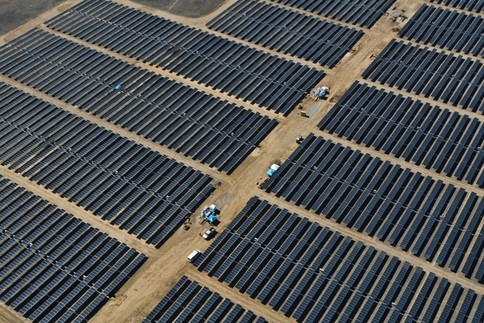It’s well-known that China ranks first in the world in attracting clean energy investment, receiving US$ 65.1 billion in 2012. But new analysis from WRI shows another side to this story: China is increasingly becoming a global force in international clean energy investment, too. In fact, the country has provided nearly $40 billion dollars to other countries’ solar and wind industries over the past decade.
This investment is consistent with a broader trend of major emerging economies like China, India, and Brazil becoming important sources of global overseas investments. WRI’s new working paper, China’s Overseas Investments in the Wind and Solar Industries: Trends and Drivers, helps to better understand China’s renewable energy investments overseas, as well as the policy and market forces that drive them.
China’s overseas wind and solar investments, by the numbers
According to our research, Chinese companies have made at least 124 investments in solar and wind industries in 33 countries over the past decade (2002 – 2011), more than half of which were made in 2010 and 2011 (see Figure 1). Despite some gaps in the data that prevent us from generalising about all of China’s wind and solar investments, we learned that:
- Of the 54 investments for which financial data were available, the cumulative amount invested came to nearly US$40 billion.
- China invested roughly US$10 billion in 16 wind projects and US$27.5 billion in 38 solar investments.
- Of 53 investments with capacity data available, the cumulative installed capacity added was nearly 6,000 MW.
- The majority of investments were in electricity generation. Several investments were made in manufacturing facilities and to establish sales and marketing offices.
- Most of the investments were in developed countries. A huge amount went to the United States, as well as Germany, Italy, and Australia. A handful of developing countries—including South Africa, Pakistan, and Ethiopia—also attracted multiple investments.
Market factors drive overseas investments
China’s investments in the wind and solar industries are driven by many factors. Both wind turbine and solar photovoltaic (PV) manufacturing industries have grown substantially – in 2010, four Chinese companies from each industry ranked among world’s top 10 manufacturers for wind turbine and solar PV respectively. However, their market bases are quite different – China’s wind industry relies on its vast yet oversupplied domestic market, whereas the solar industry relies on the international market for 95 per cent of its sales.
Both industries need to boost sales in international markets, which has not always been easy. Chinese wind companies are relatively new entrants to the international markets. Declining subsidies in the European solar market have decreased demand for Chinese solar products. As a result, direct investments overseas are seen as a way of retaining and expanding market share, typically through creating demand for the export of products.
Additional factors that support overseas investments
Other factors that motivate investment include:
- the quest for new technologies
- opportunities to acquire undervalued assets in the wake of the financial crisis
- the financing support provided by state banks for overseas investments and engineering, procurement, and construction
- policy support from the Chinese government
- renewable energy targets and tax benefits in host countries
What effect will this investment have on the climate?
Understanding China’s overseas investments in renewable energy is a start towards exploring the climate change impacts of these investments. With its low-cost financing and a robust renewable energy industry, China has the potential to advance clean energy development in countries across the world.
China still has more work to do, though, for its investments to be truly supportive of global climate change goals. For one, China will need to rapidly scale its renewable energy investments globally—especially in developing nations. It will also need to shift away from investments in fossil fuel energy, such as coal and petroleum, which currently make up the lion’s share of China’s overseas energy investments, along with hydropower investments.
But if current trends and drivers are any indication, China’s renewable energy investments will continue to grow over the coming years. If accelerated and scaled, these investments can substantially contribute to building a global, low-carbon economy.
WRI experts Yingzhen Zhao and Hu Tao will present on this topic at the upcoming event, “Scaling Up: Chinese Renewable Energy Investments in the United States and Beyond.” The event takes place Monday, June 10th at the Woodrow Wilson Center in Washington, D.C.
Yingzhen Zhao is a research assistant for the International Financial Flows and Environment (IFFE) project at the World Resources Institute, while Clifford Polycarp is a senior associate for the Institutions & Governance Program.


